Farmers say turbines would be big economic benefit to community
Apex plans to take people on tours of other wind farms to hear directly from landowners, government officials
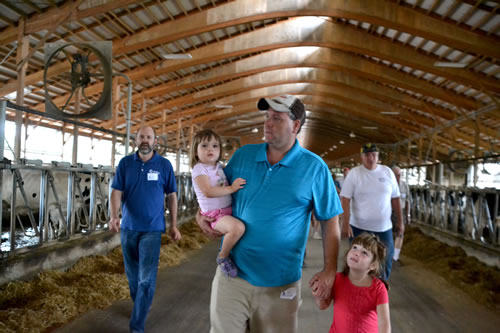
Photos by Tom Rivers – Ben Martin walks through a barn with his daughters Lydia (in his arms) and Adeline during a tour of the farm with other supporters of the Lighthouse Wind project on Wednesday. Ben and his brother are partners and sixth-generation owners of a dairy farm on Lower Lake Road in Somerset. Karlis Povisils, vice president of development for Apex, is at left.
SOMERSET – It’s been a tough year for Atwater Farms, a dairy that dates back to 1852. Milk prices are low for farmers, and the drought conditions have hurt yields for feed for the cows.
Ben Atwater and his brother Seth are partners at Atwater Farms, sixth-generation owners of a farm that milks 1,020 cows.
They also are supporters of Lighthouse Wind. They have signed a lease with Apex Clean Energy to have turbines on their land.
Ben Atwater, 39, says the farm wouldn’t get rich by having turbines, but the revenue would certainly help, and be reliable income in a tough year like 2016.
“If we can get a little bit of money in the down years it would help sustain us long-term,” he said on Wednesday, when his farm hosted a tour and pig roast for supporters of Lighthouse Wind.
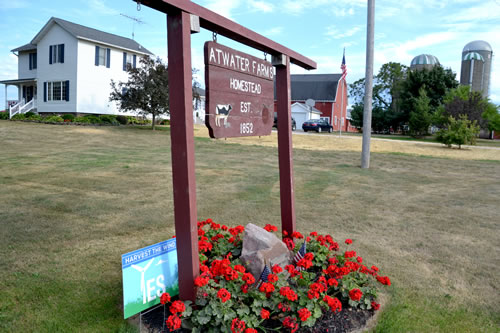
Atwater Farms on Lower Lake Road near the Golden Hill State Park keeps a sign in the farm’s front yard in support of the Lighthouse Wind project.
Apex has leases with many of the dairies and larger land owners between Route 18 and Lower Lake Road in Somerset. Atwater’s neighbor Charlie Lyndacker has a meteorological tower on his property. That MET tower has confirmed a strong wind presence for the project, said Karlis Povisils, vice president of development for Apex.
The company is going through the permitting process with New York, which Apex officials believe will take another 1 ½ to 2 years. The company would like to erect nearly 70 turbines in the towns of Yates and Somerset, with the turbines generating 201 megawatts of electricity.
Lyndacker and his father, Elmer, are from Lowville in the North Country. They go back home often, transporting heifers and dairy animals. They saw wind turbines go up in the Tug Hill region, resulting in an economic boost for that area.
“Tug Hill had more or less been abandoned,” the elder Lyndacker said. “The windmills have been a godsend to them.”
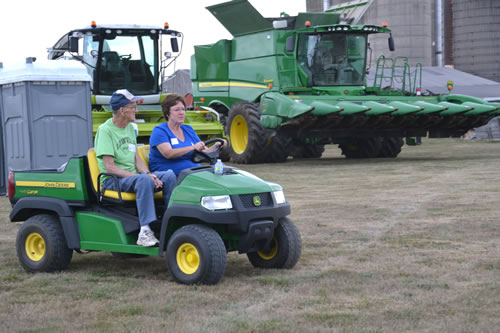
Elmer Lyndacker rides with Susan Atwater on a tour of the Atwater dairy farm on Wednesday evening.
Elmer Lyndacker said Lighthouse Wind has resulted in strained neighbor relations. Yards on Route 18 and the side roads show many signs either in support or against the project.
Officials in both Yates and Somerset have formally opposed Lighthouse Wind, and county and state officials, as well as Congressman Chris Collins oppose it. Collins says it could endanger the area’s chances of keeping the military base at Niagara Falls.
Other detractors worry the turbines, which would peak at over 600 feet, would harm wildlife, property values and disrupt the peacefulness in the rural countryside.
“It’s like a Civil War in Somerset,” Lyndaker said. “I hope it goes through. I have no objection to them.”
Willard Martucci of Yates is an outspoken supporter of the project, even though he doesn’t have a lease with the company. Martucci has a trucking company. In a busy year, he has five employees. This year he has three.
“We need jobs,” he said at Wednesday’s gathering at Atwater’s. “There is nothing here.”
Martucci and his wife Carol told about 50 people at the Atwater event they were camping in Laramie, Wyoming, with nearly 200 wind turbines nearby. They didn’t hear them.
“You could hear the sound of the wind, just like here,” Martucci said. “(The turbines) boosted their economy, and they were thankful. That’s what we need here.”
Gary Thering owns a 102-acre farm on Millers Road in Yates. He has cows, corn, fruit and hay at his farm.
He would like to have a turbine on his land. He said the turbines take up about a half-acre. He would gladly give that up for the steady revenue from a turbine.
“Your land is a resource and you have to get as much out of it as you can, and still take care of the land,” Thering said.
He came up with the words for a banner that Apex has been displaying at the county fairs in Orleans and Niagara counties: “Providing Energy from a breath of Fresh Air.”
Thering said the turbine project would be a lift to the local economy, and would also mean less burning of fossil fuels.
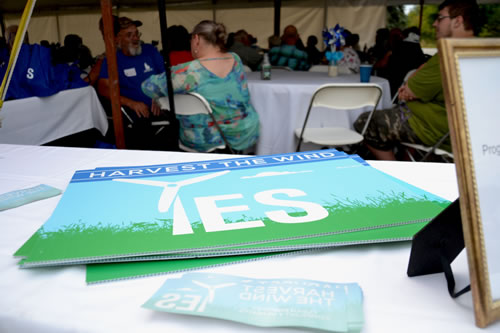
Apex is giving out signs in support of Lighthouse Wind, urging the community and state to “Harvest The Wind” and say “Yes” to the project.
Apex also said it will follow a suggestion from Howard Pierce, a Lighthouse Wind supporter from Yates, to take people on tours of other wind farms so they can hear directly from landowners, residents and government officials about the projects. Apex said it will reach out to communities in the North Country, where several projects have been built and are under development in northern New York.
“People often ask me, ‘What does a wind turbine look like and sound like,'” Taylor Quarles, development manager for Apex, told the group at Atwater. “I say, ‘Go see one.'”
Quarles said visiting communities with wind turbines will provide “a more real-world experience” and let local residents speak directly with people affected by projects.
Quarles and Apex officials took questions from supporters on Wednesday. They were asked if there is a decommissioning plan for the turbines.
Quarles said the leases with landowners make provisions for removing the turbines, which he said are expected to have a useful life of 30 years. If Apex secures a permit for the project from the state, one stipulation includes a plan and funds for removing turbines. The company needs to have a decommissioning bond from a third party for removing turbines and restoring the land, Quarles said.
“There is absolutely no way, after 30 years, a wind turbine will sit there rusting or be left with a town or landowner to deal with,” Quarles responded to the question.
Apex also will need to work out agreements with municipalities for restoring roads after the construction.
“We know we’re going to have to pay for what we take out of the roads,” said Povisils, vice president of development for Apex.
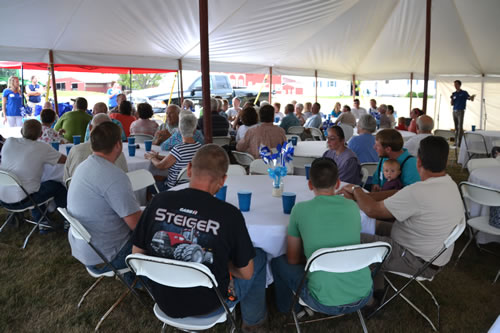
About 50 people who support the Lighthouse Wind project gathered at Atwater Farms in Somerset to hear from Apex officials on Wednesday evening.
Apex was asked what happens if another company acquires the Lighthouse project. Quarles said the leases and permit standards would pass to a new company, should Apex sell it. The company built five projects last year and did sell one, although Apex is the operator and contact for lease holders.
Quarles said he expects Apex will be the owner and operator for its projects in New York. The company is ramping up its presence in New York and the Northeast, adding employees and planning investments.
New York has set a goal for having 50 percent of the power in the state be provided by clean energy sources by 2030. That would be about double the current percentage from clean energy. That goal, announced Aug. 1 by the New York State Public Service Commission, makes New York fertile ground for wind energy projects, said Dan Fitzgerald, senior director of development for Apex in the northeast.
The state also has a strong agricultural sector, and farmers tend to be supportive of wind energy projects around the country, Povisils said.
“In New York wind energy is compatible with agriculture,” he said. “It helps diversify their income. (The turbines) aren’t susceptible to weather and prices.”
Quarles said Wednesday’s pig roast (from a pig Apex bought at the 4-H market auction in Orleans County) was intended to thank landowners and supporters for backing the project. Quarles said the company wouldn’t be able to advance the project without leases from landowners.
“We’re a private company,” he said. “We’re not taking land through eminent domain.”
The project’s target area runs near Route 18 from north of Lyndonville to the Somerset coal plant.
Atwater, the dairy farmer, said the project has been controversial. But he thinks the community will support Lighthouse Wind if the turbines are built. He said they will become an accepted part of the landscape.
“I think after they’re up a couple of years they will be just like utility poles,” he said.









































































